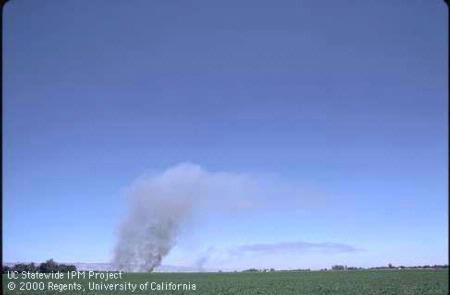If you have ever wondered why smoke rising during calm weather when there is a "ceiling", where there is warm air sitting on cold in an inversion, here is an explanation from our biometeorologist Rick Snyder at UC Davis.
The smoke rises because the heated air is less dense than the surrounding air. As it rises, it cools due to air expansion, cooling due to radiation from the heated air, and entrainment of surrounding air into the rising smoky air. In an inversion, temperature increases with height but the rate of temperature increase with height decreases with height above the ground until it becomes isothermal and then starts to decrease with further height. As the smoky air rises, it cools and the density decreases. Eventually, in a strong inversion, it will reach a level where the density of the smoky air is the same as the surrounding air and it will stop rising. Since the rising air continues to add mass (air) to the level where the density is the same, it has to spread out and mix with the ambient air with the same density at that level. You can't increase the mass of air at the point where the smoky air reaches a level having the same density, so the smoky air spreads out horizontally. If air temperature decreases with height, it is called a lapse condition and it typically the atmosphere cools at about 1oC per 100 m. The smoky air would have to cool much faster than 1oC per 100 m to cool to the point where the density of the smoky air and surrounding air is the same. The smoky air will be warmer than the surrounding air and will continue to rise and eventually entrain with the surrounding air and dissipate. You will see the smoke spread out in inversion but it will continue to rise and dissipate in a lapse condition.
There you go.
Attached Images:
